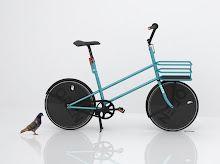The People for Bikes website has a nice, short article about the recent very rapid increase in cycling mode share in Seville, Andalusia (Spain), location of the Velo-city cycling conference which ends tomorrow. The separated cycling infrastructure - Seville was awarded the UN Habitat Best Practice Award for it's creation - was cited as the main reason for this.
The bike mode share is about 7%. What is the breakdown regarding gender, age and income level?
I am also curious about this excerpt:
“Great is the enemy of good.” The city’s infrastructure emphasizes network connectivity, not perfection. It’s far from the polished bikeways of Northern Europe, but the protected bikeways of Seville are safe, convenient and get you where you need to go without interruption.
First of all, I am happy to find out that most bike space was taken from car space.
But I don't understand how bike space taken from pedestrian space can be compensated elsewhere. After all, it's not like carbon and e.g. trees -- and how do pedestrians move in these spaces after losing space? Of course it is just political.
What is the lack of "perfection"? I would guess that the writer from People for Bikes was referring to what a Catalonian mobility consultant told me about: The two-way paths such as the one in the photo above - and this seems to be the most common design - which are narrow (two wider cargo/child-carrying bikes passing would need to veer into other space if available and of course if people are allowed to/want to ride side-by-side it is dangerous and/or illegal and one would constantly need to accelerate in front of or drop behind their travel partner.)
Certainly this lack of perfection - and conditions are certainly not perfect in many Northern European towns or even the best of them - is less important if unwarranted by the great but still low 7% mode share - but what if demand increases further? Will there be enough pressure to, for example, make double lanes single and a counterpart added to the other side of the street? The example photo in the linked article has a two-way on a one-way street which looks a 3- or 4-lane motorized traffic canal with parking removed on one side for the bike stuff.
And regarding "without interruption" I would like to see an example of major crossroads. Hopefully some colleagues and others who are there can fill us in.
Last but certainly not least, do the citizens of Seville deserve less than people in Amsterdam, Copenhagen etc. ? Certainly not, and regarding budgets and politics the very important question that needs to be made is if infrastructure for motor vehicles is just as far from perfection there.
From what I have read and heard there are other things which help make Seville great. It is certainly always a bit nicer to cycle in the sunshine with a good meal of fresh food at the end of your journey.





4 comments:
Well, the Sevilla issue is not so easy to comment.
First of all, I must tell you that Sevilla has increased its number of cyclist enormously, even when the percentage of the rise is not so high than they show in their data, just because they don't mention they didn't take account of pedestrians when they calculate de modal split (and pedestrians mean a 36% of all travels).
http://bicicletasciudadesviajes.blogspot.com/2011/02/cambio-modal-realidad-o-ficcion.html
It's true that most of space taken for cycle paths comes from parking lots, but what is also true is that, in most of the cases, cycle paths are done at sidewalk level, so they interfer the walking itineraries, mostly on crossings.
You are right when you spot the question of the spaces stolen to pedestrians. I also want to add the freedom drop from them, that is maybe more difficult to value and impossible to return.
About the type of cycle path choosen, I agree that is really narrow, problematic because of the bi-directionality and not enough well managed at junctions, but people is happy or, at least, easy-going with them.
Check it out here:
http://bicicletasciudadesviajes.blogspot.com/2011/03/el-carril-bici-de-sevilla-cuidado.html
Or here:
http://bicicletasciudadesviajes.blogspot.com/2010/03/aceras-bici-y-estres-peatonal.html
I hope this responds to your questions.
Thanks, Eneko. Regarding the loss of pedestrian freedom, I suppose this gets offset in part or in some way by the mode transfer from cars to bikes...
I was happy to see that in Sevilla things are happening on the streets.
As a tourist I really enjoyed the 'ringroad' cycle track.
- Yes it was narrow, but it was never really dangerous and people were not annoyed.
- There were men, women and children of all ages on this ring road using it for utility purpuses, but also recreation.
- there were cyclists, roller blades and also people with wheel chairs.
- before reaching a zebra crossing there are signs on the pavement: 10 - 5 - to warn you if you look down in stead of around you.
- it was easy to find my way - I just had to be sure to reach the ring road at some point and I knew I would be able to find my pension.
Within the ringroad in the middle of the city I found 2 types of what I call 'Spanish Shared Space'
- the very inner part has a BRT system in a pedestrian & bike area - busy with people, really good atmosphere - smooth surface to bike on
- the 2nd type being narrow streets with cobble stones; cars drive slowly, bikes as well. Many people walking. No special features or infra, no conflicts that I was aware of
All in all: no perfection - I enjoyed it a lot
well...
those cycle paths certainly have the merit of being there.
But they're
- too narrow
- dangerous at crossings without lights because of inherent dangers to two-way paths
- very annoying at crossings WITH lights-you spend half your cycling time waiting because you often have to cross two times to get where you want
- they do not reduce in any way the speed of car traffic probably just the other way round.
- they did not get me where I wanted most of the time ;-)
but it's just me, obviously ;-)
Post a Comment